Sulfur; Features and applications
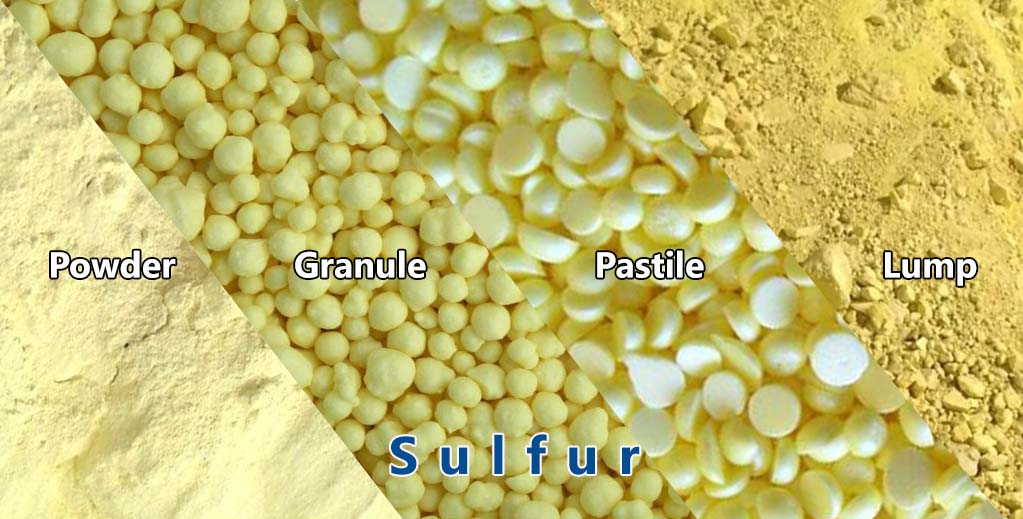
All about refinery and mineral sulfur
Sulfur is a chemical element with the symbol S and atomic number 16. This substance is abundant, polyvalent, and belongs to the group of non-metals. Under normal conditions, sulfur atoms form cyclic eight-atom molecules with the chemical formula S8. Elemental sulfur is a light yellow crystalline solid at room temperature.
This is the tenth most common element by mass in the world and the fifth most common element in the earth’s crust. Although this element is sometimes found in the pure and local form in the ground, it is usually found in the form of sulfide and sulfate minerals.
Mineral sulfur was known in ancient times, and for this reason, it was used in ancient India, ancient Greece, China and Egypt. Today, almost all sulfur in the world is produced as a byproduct of removing sulfur-containing pollutants from natural gas and oil. The more commercial use of this element is the production of sulfuric acid to prepare sulfate and phosphate fertilizers and other chemical processes.
This is used in making matches, producing insecticides, and all kinds of fungicides. Many of its compounds have a pungent smell; Perhaps something similar to the characteristic smell of hydrogen sulfide or the smell of other biological processes comes to our nose.
This element is an essential element for life, but it is always used in the form of organic compounds or metal sulfides. Three amino acids (cysteine, cystine, and methionine) and two vitamins (biotin and thiamine) are compounds of organic sulfur. Many cofactors, including glutathione, thioredoxin, and iron-sulfur proteins, contain it.
this is one of the main chemical elements that are necessary for biochemical function and is considered one of the macronutrients required for all living organisms.
Contents
A Look at the History of Sulfur
This element has been known and available naturally in ancient times. English translations of the Bible usually refer to burning sulfur, giving rise to the words “fire and brimstone”; in which he informs the readers about the eternal cursed fate that awaits unbelievers and deniers.
it was used for incense in ancient Greece. The natural form of this element was known in China from the 6th century BC and was found at Hanzhong. In the 3 Third century, the Chinese discovered that sulfur could be extracted from pyrite.
Chinese Daoists were interested in the flammability of this element and its reactivity with certain metals, however, its earliest practical applications were found in traditional Chinese medicine. A Song Dynasty treatise of 1044 AD describes various formulas for Chinese black powder, which is a mixture of potassium nitrate, charcoal, and sulfur.
Elemental sulfur was used to relieve diseases such as scabies, ringworm, psoriasis, eczema, and acne. Its mechanism of action remained unknown at that time; However, sulfur is slowly oxidized to sulfurous acid, which is a mild antibacterial and reducing agent.
Antoine Lavoisier used sulfur in combustion experiments and published some of these in 1777. Its deposits in Sicily have been a major source for more than a century. In the late 18th century, about 2,000 tons per year of mineral sulfur were imported into Marseille, France, to produce sulfuric acid for use in the Leblanc process.
In 1867, mineral sulfur was discovered in underground mines in Louisiana and Texas. In the late 18th century, furniture makers used molten sulfur to produce decorative inlays in their crafts. Due to the production of sulfur dioxide during the melting process, this use in the intarsia industry was gradually abandoned.
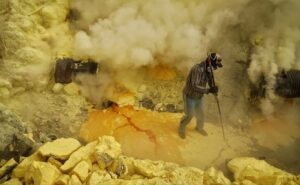
Pure sulfur powder was also used as medicine and laxative. Today, most of the sulfur produced is used to prepare sulfuric acid for a wide range of applications, especially agricultural fertilizer.
Sulfur production methods
this element may be found by itself in mines, and historically it has been proven that it was obtained in this way. “Pyrite” has also been a source of sulfur. In the volcanic regions of Sicily, in ancient times, it was found on the surface of the earth.
Elemental sulfur was extracted from salt domes until the end of the 20th century. this element is now produced as a byproduct of other industrial processes such as oil refining, where sulfur is an undesirable compound.
Today, sulfur is produced from oil, natural gas and fossil resources, which is mainly obtained in the form of hydrogen sulfide structures.
R-S-R +2 H2 →2 RH + H2S
The hydrogen sulfide resulting from this process and also as it happens in natural gas, is converted into sulfur by the “Claus” process. This process involves the oxidation of some hydrogen sulfide to sulfur dioxide:
3 O2 +2 H2S →2 SO2 +2 H2O
SO2 +2 H2S →3 S +2 H2O
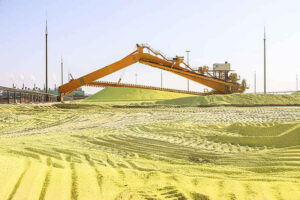
Properties of sulfur
Physical properties
Sulfur forms several models of polyatomic molecules—the most famous allotrope or octa sulphur, cyclo-S8. Inorganic sulfur, or octasulfur, is a precursor a soft, light yellow solid that is odorless, but impure samples have a match-like odor.
This elemental compound melts at 115.21 degrees Celsius (38.239 degrees Fahrenheit); It boils at 6.444 °C (3.832 °F) and sublimation easily.
Between the melting and boiling temperatures, octa sulphur changes its allotrope again, changing from β-octasulfur to γ-sulfur, which is again associated with lower density but increased viscosity due to the formation of polymers. At a higher temperature, the viscosity decreases due to depolymerization.
Molten sulfur has a dark red color; This occurs state at temperatures above 200°C (392°F). The density of it depends on its allotrope, about 2 grams per cubic centimeter. All stable allotropes of this element are electrical insulators.
Chemical properties
Sulfur burns with a blue flame, forming sulfur dioxide, which has a suffocating and irritating smell. it is insoluble in water, but soluble in carbon disulfide and partially soluble in other non-polar organic solvents such as benzene and toluene.
Inorganic sulfur allotropes
this element forms more than 30 solid allotropes. In addition to S8, several other rings are also known. By removing an atom from the crown of the ring, S7 is formed, which is more Comparatively yellow than S8. Amorphous sulfur is produced by rapid cooling of molten sulfur.
Sulfur polyanions and polycations
When this element reacts with mild oxidizing agents in a Fully acidic solution, sulfur polycations, S42+, S82+, S162+, are produced. Colored solutions produced by this element in oleum were first discovered by Buchholz as early as 1804, but the cause of the color and the structure of the corresponding polycations were elucidated in the late 1960s. S42+ is yellow, S82+ is dark blue, S162+ is red.
Physical and chemical characteristics of sulfur
| Composition name: sulfur / S8 | |
| Other names: Sulphur sulfur | |
| Identifier indicators | |
| CAS Number | N/A |
| E number | N/A |
| KEGG | N/A |
| PubChem CID | N/A |
| Features and properties | |
| Chemical formula | S |
| Atomic weight | 32 |
| Appearance | Yellow crystalline solid or powder |
| Smell | Odorless |
| Density | Alpha structure : 2/07 g/cm3 Beta structure : 1/96 g/cm3 Gamma structure : 1/92 g/cm3 |
| Melting point | 388/36 °C |
| Boiling point | 717/8 °C |
| Molar heat capacity | 22/75 J/(mol.K) |
| Solubility in water | insoluble |
| Solubility in other solvents | A small amount dissolves in carbon disulfide A small amount dissolves in toluene and benzene |
| Acidity (pKa) | N/A |
| Thermochemical properties | |
| Standard molar entropy (So298) | N/A |
| Standard enthalpy formation (ΔfH⦵298) | N/A |
| Related compounds | |
| Other related and similar compounds | Hydrogen sulfide Sodium sulfide Sulfur dioxide Sulfur trioxide Sodium dithionite Thiosulfate Sulfuryl chloride Chlorosulfuric acid Sulfur tetrafluoride Sulfur dichloride |
Applications of sulfur
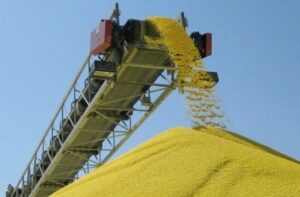
Production of sulfuric acid
Elemental sulfur is used as a precursor for some chemicals. Approximately 85% of inorganic sulfur is converted to sulfuric acid:
2 S +3 O2 +2 H2O →2 H2SO4
This element used to produce sulfuric acid is of the refinery type. Refinery sulfur is divided into two basic types, gaseous (GC) and petroleum (OC), In order to produce sulfuric acid, mainly gaseous basic sulfur is used, which is more acidic.
Preparation of other chemical compounds
Sulfur reacts directly with methane to produce carbon disulfide, which is used to produce cellophane and rayon. One of the applications of elemental sulfur is in boiling rubber; When polysulfide chains form organic polymers.
Many surfactants and detergents (eg sodium lauryl sulfate) are sulfate derivatives. Calcium sulfate and gypsum are also produced using this elemental sulfur.
In agriculture to prepare fertilizers
Sulfur is used as an important component in chemical fertilizers. The most important form of this element for material fertilizer is the mineral calcium sulfate. Mineral sulfur is hydrophobic (not soluble in water) and cannot be directly used by plants. Over time, soil bacteria (Thiobacillus bacteria) can convert it into soluble derivatives, which can then be used by plants.
In agriculture, mainly bentonite sulfur with a purity of 90% sulfur and 10% bentonite or 75% sulfur is used and it is used as a hand sprayer or as a fertilizer.
This element improves the absorption of other essential plant nutrients, especially nitrogen and phosphorus. Biologically produced these element particles are naturally hydrophilic due to their biopolymer coating and are diluted in the slurry solution and dispersed on the ground due to faster absorption.
The plant’s need for sulfur-containing fertilizers is equal to the need for phosphorus fertilizers or even more. The amount of fertilizers used for trees and plants is different. The amount of this element for the almond tree is different from other trees.
read more: urea suppliers
Preparation of fungicides and pesticides
Elemental sulfur is one of the oldest fungicides and pesticides. Primary sulfur in powdered form is a common fungicide for grapes, strawberries, many vegetables, and several other crops. This substance has a positive effect against a wide range of “mold” and “black spot” diseases. In organic farming, this element is the most important fungicide.
This element is used in powder and solid form to repel pests. In another method, this dust is mixed with some water to wet it on the plant and destroy the pests.
Elemental S powder is used as an “organic” insecticide (actually a lethal toxin) to protect the plant from mites (Sulphur Miticide).
Food preservation to kill bacteria
Small amounts of sulfur dioxide gas were used in the past for the alcoholic beverage industry. This prevents the growth of aerobic bacteria, which otherwise turns ethanol into acetic acid and makes the drink taste sour.
Sulfur dioxide and various sulfites are used in many other sectors of the food industry due to their preservative, antioxidant and antibacterial properties. Since reports of allergic reactions in some people to sulfites in foods, this practice has been in decline.
Pharmacology
this element (in the structural form of octasulfur or 8 atoms) is used in skin medicines and acne treatment medicines. This substance kills bacteria, fungi, scabies, mites, and other parasites.
Precipitated sulfur and colloidal sulfur are used in the form of lotions, creams, powders, soaps, and bath detergents to treat acne vulgaris, acne, and dermatitis. Common side effects of using these products include skin irritation, dryness, itching, and peeling.
Application in the furniture industry
this element can be used to create decorative intarsia in wooden furniture. After a design is cut into the wood, molten sulfur is poured. Sulfur inlay was especially popular in the late 18th and early 19th centuries. This method soon became obsolete as toxic and flammable materials were substituted.
The biological role of sulfur
Protein and organic cofactors
this element is one of the basic components of all living cells. This substance is the seventh or eighth most abundant element in the human body in terms of weight, which is equal to potassium in terms of abundance and is found a little more than sodium and chlorine. The body of a 70 kg human has about 140 grams of this element.
In plants and animals, amino acids cysteine and methionine contain sulfur, and this element is present in all polypeptides, proteins and enzymes containing these amino acids.
In humans, methionine is an essential amino acid that must be obtained through food or supplements. The enzyme “sulfite oxidase” is required for the metabolism of methionine and cysteine in humans and animals.
Metalloproteins and inorganic cofactors containing sulfur atoms
Metalloproteins, in which the active place is a metal complex bound to S atoms, are essential components of enzymes in electron transfer processes. For example, we can mention blue copper and nitric oxide reductase proteins.
Other examples include sulfur-iron clusters and many copper, nickel, and iron proteins. Furoxins act as electron carriers in cells.
In bacteria, important nitrogenase enzymes contain a Fe-Mo-S cluster and are a catalyst that performs the important function of nitrogen fixation; That is, it converts air nitrogen into ammonia, which can be used by microorganisms and plants to make proteins, DNA, RNA, alkaloids, and other nitrogenous organic compounds necessary for life.
Safety
Elemental sulfur, like many soluble sulfate salts, is non-toxic. When this element burns in air, it produces sulfur dioxide. In water, sulfuric acid gas and sulfite are obtained. Sulfites are antioxidants that prevent the growth of aerobic bacteria. At higher concentrations, sulfur-containing acids can damage the lungs, eyes, or other tissues.
Sulfur trioxide and sulfuric acid are similarly very acidic and corrosive in the presence of water. Sulfuric acid is a powerful desiccant that can remove water molecules from sugar and organic tissue.
Burning coal or oil by industries and power plants produces sulfur dioxide, which reacts with water and atmospheric oxygen to produce sulfuric acid and sulfurous acid.
These acids are the components of acid rain and reduce the pH of soil and freshwater and sometimes harm the environment. They also cause chemical weathering of sculptures and structures.
Hydrogen sulfide is as toxic as hydrogen cyanide. Both have an S element. Soluble sulfide salts and soluble hydrosulfide are toxic by the same mechanism.
read more: caustic soda flakes prices
Maintenance
Store solid sulfur in a cool, dry, well-ventilated area away from incompatible materials. Sulfide hazards must be considered when storing or transporting liquid sulfur. Hydrogen sulfide gas can accumulate in the area and is very dangerous.
Workers who deal with this substance should refrain from smoking in the warehouse and workplace.
It is dangerous for packages of this composition to be close to electrical installations and equipment.
655NFPA standard for fire and explosion prevention must be followed.
Protect well from hot liquid sulfur.
Do not use gasoline or solvents (naphtha, kerosene, etc.) to wash the contact area with this compound!
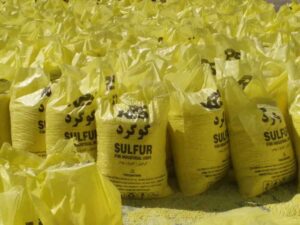
Packing Sulfur powder and lumps are available in 25 kg bags or 1000 kg jumbo bags. For gaseous sulfur and liquid sulfur, tanks are usually considered to have a certain volume. Bag sulfur is supplied in 30-40 kg packages.
where is sulfur found?| Introducing the Ten Biggest Sulfur Mines in the World
Most of the sulfur produced today is recovered from natural gas and petroleum, but some is still mined from volcanic regions and sulfide ores. these are the ten biggest sulfur mines in the world, based on their production in 2022.
1. China: China is the world’s largest sulfur producer, with an estimated output of 18 million metric tons in 2022. China’s sulfur mainly comes from the recovery of natural gas and petroleum, as well as from pyrite mining in provinces such as Shanxi, Sichuan, and Yunnan.
2. United States: The United States is the second-largest sulfur producer, with an output of 8.6 million metric tons in 2022. About 93% of the US sulfur is recovered from natural gas and petroleum, especially from the Gulf Coast region. The US also has some sulfur mines in states such as Texas, Louisiana, and Wyoming.
3. Russia: Russia is the third-largest sulfur producer, with an output of 7.3 million metric tons in 2022. Russia’s sulfur mainly comes from the recovery of natural gas and petroleum, as well as from sulfide ore mining in regions such as Siberia and the Urals.
4. Saudi Arabia: Saudi Arabia is the fourth-largest sulfur producer, with an output of 7 million metric tons in 2022. Saudi Arabia’s sulfur mainly comes from the recovery of natural gas and petroleum, especially from the Arabian Peninsula and the Persian Gulf.
5. United Arab Emirates: The United Arab Emirates is the fifth-largest sulfur producer, with an output of 6 million metric tons in 2022. The UAE’s sulfur mainly comes from the recovery of natural gas and petroleum, especially from the Abu Dhabi Gas Development Project (Shah Gas Field).
6. Canada: Canada is the sixth-largest sulfur producer, with an output of 4.9 million metric tons in 2022. Canada’s sulfur mainly comes from the recovery of natural gas and petroleum, especially from Alberta and British Columbia. Canada is also the world’s largest exporter of sulfur, followed by Russia and Saudi Arabia.
7. Kazakhstan: Kazakhstan is the seventh-largest sulfur producer, with an output of 4.6 million metric tons in 2022. Kazakhstan’s sulfur mainly comes from the recovery of natural gas and petroleum, as well as from sulfide ore mining in regions such as Aktobe and Kostanay.
8. India: India is the eighth-largest sulfur producer, with an output of 3.5 million metric tons in 2022. India’s sulfur mainly comes from the recovery of natural gas and petroleum, as well as from pyrite mining in states such as Bihar and Jharkhand.
9. Japan: Japan is the ninth-largest sulfur producer, with an output of 3.2 million metric tons in 2022. Japan’s sulfur mainly comes from the recovery of natural gas and petroleum, as well as from volcanic deposits in islands such as Hokkaido and Kyushu.
10. South Korea: South Korea is the tenth-largest sulfur producer, with an output of 3.1 million metric tons in 2022. South Korea’s sulfur mainly comes from the recovery of natural gas and petroleum, as well as from imported sulfide ores.
11. Indonesia: Indonesia is not among the top producers of sulfur worldwide, but it has one of the most unique and spectacular sulfur mines in the world: the Kawah Ijen volcano in East Java. Here, miners extract solid sulfur from inside the crater using metal pipes that bring molten sulfur to the surface where it cools into a hard yellow solid. The miners call this solid sulfur ‘Devil’s gold’, as it provides them with income but also exposes them to toxic fumes and back-breaking labor.
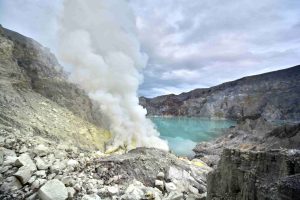
source: Statista
elemental sulfur market and buying and selling sulfur
In the market of buying and selling mineral and liquid sulfur or even gaseous sulfur, we are faced with different purity percentages. Sulfur is mainly produced by Khangiran Refinery and Khark Petrochemical Co.. Sulfur 99%, sulfur 80%, sulfur 98% and types of granulated sulfur known as mesh are the most common of this combination. The most common forms of sulfur in the market are as follows:
- Granular sulfur: It is used in the production of sulfuric acid, bentonite sulfur fertilizer, sugar and sugar bleaching.
- Lump sulfur: This type of sulfur is used to convert into micronized powders with different meshes.
- Pastille sulfur: This type of sulfur is used for agricultural purposes and in terms of characteristics, it has no difference with sulfur powder. This product is produced in a refinery.
- Micronized sulfur (mesh 200 and more): This type of sulfur is obtained by pulverizing the lump type, spraying leaves, removing grape white, etc.
- Powdered sulfur (sugar grain): The granularity of this type of sulfur is coarser than micronized and similar to sugar grains.
- Sulfur cube: This form of sulfur is made in the form of ingots after degassing and compression, and is called sulfur ingots or sulfur cubes.
Purchase of this element should be done based on need and application. This graded compound is available in powder form with 30 to 50 and 50 to 100 mesh. Sulfur or micronized sulfur powder has a grain size of 100 to 150. Depending on where its production source is, the grade of this element widely varies; Refinery sulfur usually has a purity of 5.99%. For mineral sulfur, the purity is defined as 10 to 40%. This composition is also sold in gas, liquid and lumpy form, each of which has a different price.
 Top 10 sulfur suppliers in Iran
Top 10 sulfur suppliers in Iran
Sources:
Last Seen















Users Comment
How Urea Can Hydrate and Exfoliate Your Skin
Sodium carbonate| Soda ash; features and applications
Copper Sulfate; Features and applications
Zinc sulfate; Features and applications
Urea; Features and applications
Sodium bicarbonate; Features and applications
Ammonium Sulfate; Features and applications
What is the use of caustic soda? An Overview of the caustic soda uses
Caustic soda flakes and the methods of production
Analysis of September manufacturing trends in Asia
The impact of growth in major Asian economies on petrochemical demand
Aramco loan $2 billion to Petro Rabigh to cover cash shortfall
16Th International ArabPlast 2023
International Iran Conmine 2023
International Iran Nano 2023
17Th International Iranplast Fair 2023
12th International Composite Expo 2023
International IFarm Agro Fair 2023
22Nd International Paint Resin Coatings Fair
Sodium carbonate| Soda ash; features and applications
Copper Sulfate; Features and applications
Zinc sulfate; Features and applications
Urea; Features and applications
Sodium bicarbonate; Features and applications